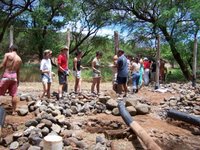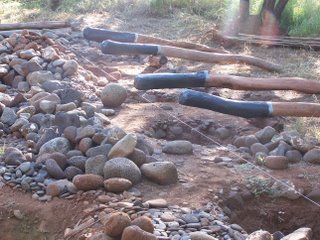entry three

Today, the hale hale pouhaku had to be moved from the kai to the site of the hale. Craig, the man in charge of building, placed a kapu aloha on all negative talk and distraction, so that the work would be done well and the pouhaku (stones) granted mana. We cleansed ourselves in the ocean as the sun came up before eating a good breakfast. From there we made a line on the beach, stretching from the foreshore, to pass rocks along between us hand to hand.
 Ellen stayed at home and started to make a gift to give to the builders of the hale. She felt full of allergy and her eyes hurt to open. Living naturally so close to the earth and sky is not all wonder and excitement. She ate breakfast at home and only just made it out to lunch.
Ellen stayed at home and started to make a gift to give to the builders of the hale. She felt full of allergy and her eyes hurt to open. Living naturally so close to the earth and sky is not all wonder and excitement. She ate breakfast at home and only just made it out to lunch.
The line didn't quite stretch the whole way to the hale and so after an hour's work we moved the the line and ferried those same rocks the last hundred yards. There was a lot of good concentration and the mana flowed well between us, even when the people were throwing and not simply passing the stones. After lunch we worked again. Uncle Maka and Craig raised poles and braced them in the ground with our pouhaku. We made a surprisingly small dent in the need for rocks.
 This afternoon the men and women separated to do their own things, as per Hawai'ian custom, and to talk story to each other. We continued to carry rocks for an hour or so, just the men, and then Kawai showed us a game called Hakoko - a type of Hawai'ian wrestling. The two men slap hands before the referee shouts "O - O - O'ie", they use open hands to grapple and unbalance their opponent. Only the soles of the feet must touch the ground and no head holds are allowed. There is a limiting perimeter with a diameter of only a man's height, and so bouts are over quickly, one way or another. Some of us were a little nervous to start but soon realised it was a very fun game. Everybody wrestled in a round-robin, starting with the low weights and the winner staying on. The game is about strength, balance and technique. I won one round and lost three. The purpose of all this appeared to be to prepare us for a fight, to sort out the pecking order, and to bond us together. We all felt happier and more like brothers after the game.
This afternoon the men and women separated to do their own things, as per Hawai'ian custom, and to talk story to each other. We continued to carry rocks for an hour or so, just the men, and then Kawai showed us a game called Hakoko - a type of Hawai'ian wrestling. The two men slap hands before the referee shouts "O - O - O'ie", they use open hands to grapple and unbalance their opponent. Only the soles of the feet must touch the ground and no head holds are allowed. There is a limiting perimeter with a diameter of only a man's height, and so bouts are over quickly, one way or another. Some of us were a little nervous to start but soon realised it was a very fun game. Everybody wrestled in a round-robin, starting with the low weights and the winner staying on. The game is about strength, balance and technique. I won one round and lost three. The purpose of all this appeared to be to prepare us for a fight, to sort out the pecking order, and to bond us together. We all felt happier and more like brothers after the game.
 The group of us also had the opportunity to talk a little about culture. John shared with us the idea of what is pono and what is not pono, what is right to do in life and what is not. He also explained how the Kaho'olawe project is connected to the effort to promote Hawai'ian values and lifestyles alongside the American culture. John explained the process using sand on the beach to show the difference between linear western-style progression in life, and his conception of concentric circular learning in a traditional Hawai'ian way.
The group of us also had the opportunity to talk a little about culture. John shared with us the idea of what is pono and what is not pono, what is right to do in life and what is not. He also explained how the Kaho'olawe project is connected to the effort to promote Hawai'ian values and lifestyles alongside the American culture. John explained the process using sand on the beach to show the difference between linear western-style progression in life, and his conception of concentric circular learning in a traditional Hawai'ian way.
After our man-time we went to the hale and helped build by filling in cracks with ili'ili, little round stones to wedge between the larger ones. Each pou (pole) sits on top of a kumupouhaku to let the rain run off,  and fish and leaves are placed around on which the base rocks sit. It was a good deal of effort to get the pou in line and straight whilst placing the rocks. Patience is the key!
and fish and leaves are placed around on which the base rocks sit. It was a good deal of effort to get the pou in line and straight whilst placing the rocks. Patience is the key!
I went bathing with the kua after that and jumped off a rock into high surf. It felt like being in a washing machine, but strangely I was comforted by the sea, held up by it. It was hardest getting out, where the wave brought you up to a rock and the idea was you just stepped up on to it. In the end Kawai literally plucked me out of the ocean to safety. Being there was a thrill and an honour, amongst these men so at ease with the land and sea.
Each evening of the trip we had spoken together after dinner and on this last night we talked about how we felt and about what we had learned on the trip. To hear the shared love and the enjoyment in people's words was a joy, and reassuring, if only to give thanks to the people whom had brought us to the island. We had developed a sense of family, although one of the biggest lessons I had learned was the value of knowing where your home is and gathering knowledge about it, as opposed to going elsewhere to discover or to study places overseas. I know both these processes have their place, and they have both certainly shaped Kaho'olawe and its people, for better or worse.


 We have been up all night watching the football on TV and are looking forward to another England game tonight at 2am. It is odd sitting up in a quiet and darkened house watching the games but I wouldn't miss it for the world. The World Cup is simply amazing. Both Ellen and I have caught colds and so we're looking after ourselves with porridge and soup and fruit. I will be in bed by 6pm this evening!
We have been up all night watching the football on TV and are looking forward to another England game tonight at 2am. It is odd sitting up in a quiet and darkened house watching the games but I wouldn't miss it for the world. The World Cup is simply amazing. Both Ellen and I have caught colds and so we're looking after ourselves with porridge and soup and fruit. I will be in bed by 6pm this evening!  Work is so easy it is no problem to arrive there after being up all night, as long as I go to bed as soon as I get home at 4pm and sleep until 12am. It's only for another two weeks and then the Cup is over. I am earning quite well and really hope to save some up for a rainy day, I must stop just saying so and start doing it, but so far it's been too tempting to enjoy Melbourne's great restaurants and bars!
Work is so easy it is no problem to arrive there after being up all night, as long as I go to bed as soon as I get home at 4pm and sleep until 12am. It's only for another two weeks and then the Cup is over. I am earning quite well and really hope to save some up for a rainy day, I must stop just saying so and start doing it, but so far it's been too tempting to enjoy Melbourne's great restaurants and bars!






















